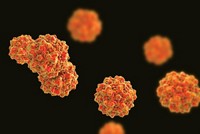Advertisement
Grab your lab coat. Let's get started
Welcome!
Welcome!
Create an account below to get 6 C&EN articles per month, receive newsletters and more - all free.
It seems this is your first time logging in online. Please enter the following information to continue.
As an ACS member you automatically get access to this site. All we need is few more details to create your reading experience.
Not you? Sign in with a different account.
Not you? Sign in with a different account.
ERROR 1
ERROR 1
ERROR 2
ERROR 2
ERROR 2
ERROR 2
ERROR 2
Password and Confirm password must match.
If you have an ACS member number, please enter it here so we can link this account to your membership. (optional)
ERROR 2
ACS values your privacy. By submitting your information, you are gaining access to C&EN and subscribing to our weekly newsletter. We use the information you provide to make your reading experience better, and we will never sell your data to third party members.
Drug Delivery
Nvelop launches to deliver gene-editing cargo
Start-up is using virus-like particles to improve gene therapies
by Sarah Braner
April 11, 2024

Nvelop Therapeutics has launched to improve gene therapy delivery. The company was first founded in 2022 with $100 million in funding from investors on the basis of independently developed platforms advanced by David Liu at the Broad Institute of MIT and Harvard and Keith Joung of Massachusetts General Hospital.
The company is developing viruslike delivery mechanisms for gene-editing cargo. Nvelop says its delivery agents can enable gene editing without taking cells out of the body, editing them, and putting them back in. This advance can make the technology applicable to more conditions, the company says.
“There [are] so many gene modifications that can be accomplished,” says Melissa Bonner, Nvelop’s chief scientific officer. “But they can only effectively be accomplished either ex vivo—outside the body—or in very limited target tissues.” That’s because delivery systems aren’t yet able to deliver to broad tissue types, she says.
First reported in the journal Cell in 2022 (DOI: 10.1016/j.cell.2021.12.021), the platform from Liu and the Broad Institute involves engineered viruslike particles that can deliver proteins and RNA complexes necessary for Cas9 gene editing and base editing. In 2023, Liu’s team reported that it could achieve prime editing using the same delivery mechanisms (Nat. Biotechnol. DOI: 10.1038/s41587-023-02078-y).
Joung’s platform is similar to Liu’s, but it uses fewer viral components. And while the Liu platform uses Gag proteins, which are derived from viruses, the Joung platform does not.
And it is possible that the Joung platform could use human-derived envelope proteins instead of viral envelope proteins on the delivery particle surface. This feature could lead the host immune system to ignore these particles, which could minimize adverse reactions.
While Nvelop did not provide specifics, it says the flexibility of these platforms will allow it to deliver gene-editing machinery to specific tissues.
Nvelop is developing the two platforms simultaneously, Bonner says, and may be able to transfer characteristics from one to the other. For example, it may be possible to use Joung’s human-derived envelope proteins with the Liu platform.
Jeff Walsh, the CEO of the company, says Nvelop can produce its own gene-editing cargo or partner to provide the delivery mechanism for another company’s gene-editing therapy. However, Nvelop has not established any concrete partnerships, nor is it ready to disclose any conditions it hopes to treat, he says.




Join the conversation
Contact the reporter
Submit a Letter to the Editor for publication
Engage with us on Twitter